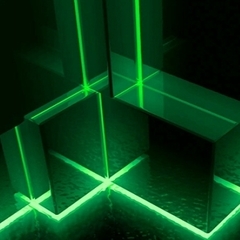-
Posts
714 -
Joined
-
Last visited
Reputation Activity
-
.png) Doramius got a reaction from PeterT in Sony's 16K Liquid Crystal LED screen - for $5Million?!?!?!
Doramius got a reaction from PeterT in Sony's 16K Liquid Crystal LED screen - for $5Million?!?!?!
Future-proofing.
-
 Doramius got a reaction from rattacko123 in Sony's 16K Liquid Crystal LED screen - for $5Million?!?!?!
Doramius got a reaction from rattacko123 in Sony's 16K Liquid Crystal LED screen - for $5Million?!?!?!
Link to Original Article
Forget 8K, Sony’s New 63-Foot 16K Crystal LED TV Is Now Available—for a Few Million
The ballpark figure is $5 million.
BY RACHEL CORMACK ON SEPTEMBER 13, 2019
Courtesy of Sony When a new gogglebox drops, it’s always the same drill: The screen gets bigger, the resolution gets better and the design gets bolder. Indeed, it’s difficult for a brand to stand out. Unless you’re Sony and the new TV your peddling is the size of a New York City public bus and also happens to boasts an unheard-of 16K screen.
Earlier this year when Sony unveiled the colossal 63-foot TV—the biggest 16K screen of its kind—it had commercial cinemas in its sights. But, hey, why should theaters have all the fun? Yesterday, the Japanese tech titan announced the Crystal LED display system will be available for home installation.
The best part? The system utilizes modular technology which means it can accommodate virtually any desired size and resolution—from a 16-foot 4K to an epic 63-foot 16K. Of course, we opt for the latter which features four times as many horizontal pixels as a 4K television and eight times that of a high-def 1080p TV. Translation: It delivers a stunning picture to a gigantic space.
Courtesy of Sony
“Crystal LED delivers over a million-to-one contrast ratio, the most accurate light levels, low heat emission and a picture quality that is absolutely breathtaking. By offering the display in modular configurations, consumers now have an exciting new option for the transition from home projection systems and large-screen TVs,” said Mike Fasulo, president and chief operating officer at Sony North America.
The micro-LED technology works like OLED, but the modules—which each measure 16×18 inches in size at 360 x 360 resolution with three tiny LEDs per pixel—are much brighter, producing 1,000 nit of brightness even though they are half the width of a human hair. The screen also boasts a 99 percent black surface area to ensure high contrast and high resolution; blur-free images with high frame rates of up to 120p; and a nearly 180-degree viewing angle.
As you might expect, the setup is not cheap. Although Sony has not yet released pricing, each module reportedly costs approximately $10,000. That means the 4K unit (which has 72 modules) would sit at around $720,000, while the 16K screen (with 576 modules) might cost up to $5 million, according to Engadget. But think of the movie tickets you’ll save on having a cinema in your own home.
_____________________________________________________
So the Main question is......When's Linus doing his review on it?
This was posted after a detailed search for anything identical or related. If this is a duplicate, please delete this post. Thank you. -
 Doramius reacted to Loote in Sony's 16K Liquid Crystal LED screen - for $5Million?!?!?!
Doramius reacted to Loote in Sony's 16K Liquid Crystal LED screen - for $5Million?!?!?!
You're ignoring:
1. Cinemas
2. Modularity
Not really, assuming software used to produce animations is even capable of doing that, the cost is crazy, usually we get 1080p with backgrounds that don't have so much detail, otherwise a singe movie costs hundreds of millions because there is a human that had to prepare the models, or, as in case of 2D animation, will just draw the same images that won't gain too much by enlarging them. And what you watch has to be interesting, so there's that part of the cost also.
Time lapses are what I've seen published in 4k at first and I think they will be just behind porn on 16k too, there's already this:
https://nofilmschool.com/First-16K-Short-Film
-
 Doramius got a reaction from EarthWormJM2 in Sony's 16K Liquid Crystal LED screen - for $5Million?!?!?!
Doramius got a reaction from EarthWormJM2 in Sony's 16K Liquid Crystal LED screen - for $5Million?!?!?!
Link to Original Article
Forget 8K, Sony’s New 63-Foot 16K Crystal LED TV Is Now Available—for a Few Million
The ballpark figure is $5 million.
BY RACHEL CORMACK ON SEPTEMBER 13, 2019
Courtesy of Sony When a new gogglebox drops, it’s always the same drill: The screen gets bigger, the resolution gets better and the design gets bolder. Indeed, it’s difficult for a brand to stand out. Unless you’re Sony and the new TV your peddling is the size of a New York City public bus and also happens to boasts an unheard-of 16K screen.
Earlier this year when Sony unveiled the colossal 63-foot TV—the biggest 16K screen of its kind—it had commercial cinemas in its sights. But, hey, why should theaters have all the fun? Yesterday, the Japanese tech titan announced the Crystal LED display system will be available for home installation.
The best part? The system utilizes modular technology which means it can accommodate virtually any desired size and resolution—from a 16-foot 4K to an epic 63-foot 16K. Of course, we opt for the latter which features four times as many horizontal pixels as a 4K television and eight times that of a high-def 1080p TV. Translation: It delivers a stunning picture to a gigantic space.
Courtesy of Sony
“Crystal LED delivers over a million-to-one contrast ratio, the most accurate light levels, low heat emission and a picture quality that is absolutely breathtaking. By offering the display in modular configurations, consumers now have an exciting new option for the transition from home projection systems and large-screen TVs,” said Mike Fasulo, president and chief operating officer at Sony North America.
The micro-LED technology works like OLED, but the modules—which each measure 16×18 inches in size at 360 x 360 resolution with three tiny LEDs per pixel—are much brighter, producing 1,000 nit of brightness even though they are half the width of a human hair. The screen also boasts a 99 percent black surface area to ensure high contrast and high resolution; blur-free images with high frame rates of up to 120p; and a nearly 180-degree viewing angle.
As you might expect, the setup is not cheap. Although Sony has not yet released pricing, each module reportedly costs approximately $10,000. That means the 4K unit (which has 72 modules) would sit at around $720,000, while the 16K screen (with 576 modules) might cost up to $5 million, according to Engadget. But think of the movie tickets you’ll save on having a cinema in your own home.
_____________________________________________________
So the Main question is......When's Linus doing his review on it?
This was posted after a detailed search for anything identical or related. If this is a duplicate, please delete this post. Thank you. -
 Doramius got a reaction from 5x5 in Samsung 860 evo or Crucial MX500 1TB
Doramius got a reaction from 5x5 in Samsung 860 evo or Crucial MX500 1TB
The reliability of the QLC is pretty low. We've had several of them overheat, and for the price, there are better options out there. You might get your faster speeds for a limited time, but the constant downtime from dead or throttled drives is not worth it. I'd rather have something more stable and reliable. Granted there are many other drives I would choose, but these are the ones that were brought up as comparison. There's a lot I'd take over a 660p.
-
 Doramius reacted to Gegger in Sony's 16K Liquid Crystal LED screen - for $5Million?!?!?!
Doramius reacted to Gegger in Sony's 16K Liquid Crystal LED screen - for $5Million?!?!?!
for my bazillion dollar miencraft setup!
-
.png) Doramius got a reaction from r2724r16 in Sony's 16K Liquid Crystal LED screen - for $5Million?!?!?!
Doramius got a reaction from r2724r16 in Sony's 16K Liquid Crystal LED screen - for $5Million?!?!?!
Future-proofing.
-
 Doramius got a reaction from r2724r16 in Sony's 16K Liquid Crystal LED screen - for $5Million?!?!?!
Doramius got a reaction from r2724r16 in Sony's 16K Liquid Crystal LED screen - for $5Million?!?!?!
Link to Original Article
Forget 8K, Sony’s New 63-Foot 16K Crystal LED TV Is Now Available—for a Few Million
The ballpark figure is $5 million.
BY RACHEL CORMACK ON SEPTEMBER 13, 2019
Courtesy of Sony When a new gogglebox drops, it’s always the same drill: The screen gets bigger, the resolution gets better and the design gets bolder. Indeed, it’s difficult for a brand to stand out. Unless you’re Sony and the new TV your peddling is the size of a New York City public bus and also happens to boasts an unheard-of 16K screen.
Earlier this year when Sony unveiled the colossal 63-foot TV—the biggest 16K screen of its kind—it had commercial cinemas in its sights. But, hey, why should theaters have all the fun? Yesterday, the Japanese tech titan announced the Crystal LED display system will be available for home installation.
The best part? The system utilizes modular technology which means it can accommodate virtually any desired size and resolution—from a 16-foot 4K to an epic 63-foot 16K. Of course, we opt for the latter which features four times as many horizontal pixels as a 4K television and eight times that of a high-def 1080p TV. Translation: It delivers a stunning picture to a gigantic space.
Courtesy of Sony
“Crystal LED delivers over a million-to-one contrast ratio, the most accurate light levels, low heat emission and a picture quality that is absolutely breathtaking. By offering the display in modular configurations, consumers now have an exciting new option for the transition from home projection systems and large-screen TVs,” said Mike Fasulo, president and chief operating officer at Sony North America.
The micro-LED technology works like OLED, but the modules—which each measure 16×18 inches in size at 360 x 360 resolution with three tiny LEDs per pixel—are much brighter, producing 1,000 nit of brightness even though they are half the width of a human hair. The screen also boasts a 99 percent black surface area to ensure high contrast and high resolution; blur-free images with high frame rates of up to 120p; and a nearly 180-degree viewing angle.
As you might expect, the setup is not cheap. Although Sony has not yet released pricing, each module reportedly costs approximately $10,000. That means the 4K unit (which has 72 modules) would sit at around $720,000, while the 16K screen (with 576 modules) might cost up to $5 million, according to Engadget. But think of the movie tickets you’ll save on having a cinema in your own home.
_____________________________________________________
So the Main question is......When's Linus doing his review on it?
This was posted after a detailed search for anything identical or related. If this is a duplicate, please delete this post. Thank you. -
 Doramius got a reaction from Doobeedoo in Sony's 16K Liquid Crystal LED screen - for $5Million?!?!?!
Doramius got a reaction from Doobeedoo in Sony's 16K Liquid Crystal LED screen - for $5Million?!?!?!
Link to Original Article
Forget 8K, Sony’s New 63-Foot 16K Crystal LED TV Is Now Available—for a Few Million
The ballpark figure is $5 million.
BY RACHEL CORMACK ON SEPTEMBER 13, 2019
Courtesy of Sony When a new gogglebox drops, it’s always the same drill: The screen gets bigger, the resolution gets better and the design gets bolder. Indeed, it’s difficult for a brand to stand out. Unless you’re Sony and the new TV your peddling is the size of a New York City public bus and also happens to boasts an unheard-of 16K screen.
Earlier this year when Sony unveiled the colossal 63-foot TV—the biggest 16K screen of its kind—it had commercial cinemas in its sights. But, hey, why should theaters have all the fun? Yesterday, the Japanese tech titan announced the Crystal LED display system will be available for home installation.
The best part? The system utilizes modular technology which means it can accommodate virtually any desired size and resolution—from a 16-foot 4K to an epic 63-foot 16K. Of course, we opt for the latter which features four times as many horizontal pixels as a 4K television and eight times that of a high-def 1080p TV. Translation: It delivers a stunning picture to a gigantic space.
Courtesy of Sony
“Crystal LED delivers over a million-to-one contrast ratio, the most accurate light levels, low heat emission and a picture quality that is absolutely breathtaking. By offering the display in modular configurations, consumers now have an exciting new option for the transition from home projection systems and large-screen TVs,” said Mike Fasulo, president and chief operating officer at Sony North America.
The micro-LED technology works like OLED, but the modules—which each measure 16×18 inches in size at 360 x 360 resolution with three tiny LEDs per pixel—are much brighter, producing 1,000 nit of brightness even though they are half the width of a human hair. The screen also boasts a 99 percent black surface area to ensure high contrast and high resolution; blur-free images with high frame rates of up to 120p; and a nearly 180-degree viewing angle.
As you might expect, the setup is not cheap. Although Sony has not yet released pricing, each module reportedly costs approximately $10,000. That means the 4K unit (which has 72 modules) would sit at around $720,000, while the 16K screen (with 576 modules) might cost up to $5 million, according to Engadget. But think of the movie tickets you’ll save on having a cinema in your own home.
_____________________________________________________
So the Main question is......When's Linus doing his review on it?
This was posted after a detailed search for anything identical or related. If this is a duplicate, please delete this post. Thank you. -
.png) Doramius got a reaction from Beskamir in Sony's 16K Liquid Crystal LED screen - for $5Million?!?!?!
Doramius got a reaction from Beskamir in Sony's 16K Liquid Crystal LED screen - for $5Million?!?!?!
Future-proofing.
-
.png) Doramius got a reaction from descendency in Sony's 16K Liquid Crystal LED screen - for $5Million?!?!?!
Doramius got a reaction from descendency in Sony's 16K Liquid Crystal LED screen - for $5Million?!?!?!
Future-proofing.
-
.png) Doramius got a reaction from soldier_ph in Sony's 16K Liquid Crystal LED screen - for $5Million?!?!?!
Doramius got a reaction from soldier_ph in Sony's 16K Liquid Crystal LED screen - for $5Million?!?!?!
Future-proofing.
-
 Doramius got a reaction from soldier_ph in Sony's 16K Liquid Crystal LED screen - for $5Million?!?!?!
Doramius got a reaction from soldier_ph in Sony's 16K Liquid Crystal LED screen - for $5Million?!?!?!
Link to Original Article
Forget 8K, Sony’s New 63-Foot 16K Crystal LED TV Is Now Available—for a Few Million
The ballpark figure is $5 million.
BY RACHEL CORMACK ON SEPTEMBER 13, 2019
Courtesy of Sony When a new gogglebox drops, it’s always the same drill: The screen gets bigger, the resolution gets better and the design gets bolder. Indeed, it’s difficult for a brand to stand out. Unless you’re Sony and the new TV your peddling is the size of a New York City public bus and also happens to boasts an unheard-of 16K screen.
Earlier this year when Sony unveiled the colossal 63-foot TV—the biggest 16K screen of its kind—it had commercial cinemas in its sights. But, hey, why should theaters have all the fun? Yesterday, the Japanese tech titan announced the Crystal LED display system will be available for home installation.
The best part? The system utilizes modular technology which means it can accommodate virtually any desired size and resolution—from a 16-foot 4K to an epic 63-foot 16K. Of course, we opt for the latter which features four times as many horizontal pixels as a 4K television and eight times that of a high-def 1080p TV. Translation: It delivers a stunning picture to a gigantic space.
Courtesy of Sony
“Crystal LED delivers over a million-to-one contrast ratio, the most accurate light levels, low heat emission and a picture quality that is absolutely breathtaking. By offering the display in modular configurations, consumers now have an exciting new option for the transition from home projection systems and large-screen TVs,” said Mike Fasulo, president and chief operating officer at Sony North America.
The micro-LED technology works like OLED, but the modules—which each measure 16×18 inches in size at 360 x 360 resolution with three tiny LEDs per pixel—are much brighter, producing 1,000 nit of brightness even though they are half the width of a human hair. The screen also boasts a 99 percent black surface area to ensure high contrast and high resolution; blur-free images with high frame rates of up to 120p; and a nearly 180-degree viewing angle.
As you might expect, the setup is not cheap. Although Sony has not yet released pricing, each module reportedly costs approximately $10,000. That means the 4K unit (which has 72 modules) would sit at around $720,000, while the 16K screen (with 576 modules) might cost up to $5 million, according to Engadget. But think of the movie tickets you’ll save on having a cinema in your own home.
_____________________________________________________
So the Main question is......When's Linus doing his review on it?
This was posted after a detailed search for anything identical or related. If this is a duplicate, please delete this post. Thank you. -
.png) Doramius got a reaction from Zando_ in Sony's 16K Liquid Crystal LED screen - for $5Million?!?!?!
Doramius got a reaction from Zando_ in Sony's 16K Liquid Crystal LED screen - for $5Million?!?!?!
Future-proofing.
-
 Doramius reacted to SurRainbow in Whats the Ta-Ra-Ra-Boom-De-Ay song from the latest TechLinked? (THIS is Google's Controller!? - Mar 11, 2019)
Doramius reacted to SurRainbow in Whats the Ta-Ra-Ra-Boom-De-Ay song from the latest TechLinked? (THIS is Google's Controller!? - Mar 11, 2019)
What is the song at the end? We want to know!
A fan made this edit, pretty good but where's the original??
https://m.soundcloud.com/uda_media/kaboom
-
.png) Doramius reacted to Orangeman2000 in Whats the Ta-Ra-Ra-Boom-De-Ay song from the latest TechLinked? (THIS is Google's Controller!? - Mar 11, 2019)
Doramius reacted to Orangeman2000 in Whats the Ta-Ra-Ra-Boom-De-Ay song from the latest TechLinked? (THIS is Google's Controller!? - Mar 11, 2019)
Singed up just for this, need to know what song this is!
-
 Doramius reacted to jamiewalkrr in Whats the Ta-Ra-Ra-Boom-De-Ay song from the latest TechLinked? (THIS is Google's Controller!? - Mar 11, 2019)
Doramius reacted to jamiewalkrr in Whats the Ta-Ra-Ra-Boom-De-Ay song from the latest TechLinked? (THIS is Google's Controller!? - Mar 11, 2019)
I want to know the house music version of the song you have in the video, as it is pretty hard to find.
-

-
 Doramius got a reaction from Techstorm970 in QNAP Launches the Mustang-200
Doramius got a reaction from Techstorm970 in QNAP Launches the Mustang-200
Article Link
QNAP Launches the Mustang-200 Computing Accelerator Card for Boosting NAS/PC computing power
Taipei, Taiwan, November 19, 2018 - QNAP® Systems, Inc. today launched the Mustang-200dual-CPU computing accelerator card with 10GbE network connectivity (available with Intel® Core™ i5 / Core™ i7 / Celeron® processors). By installing the card in a compatible QNAP NAS' (or PC's) PCIe slot, users will essentially add two processors to their system for increased computing capabilities to provide a flexible performance boost to their IT infrastructure and applications.
"As QNAP NAS evolves to support a wider range of applications, users need more storage space as well as higher computing capabilities for their NAS system. With the Mustang-200 dual-CPU computing accelerator card, users can instantly boost their system’s processing power, which is especially ideal solution for surveillance, virtualization, and AI applications,” said David Tsao, Product Manager of QNAP.
The innovative QNAP Mustang-200 computing accelerator card (PCIe 2.0 x4) features a dual CPU (including Intel® Core™ i5 / Core™ i7 / Celeron®) with Intel Graphics. By installing the card in the NAS, users can effectively increase the computing power and transcoding efficiency by the same power as two NAS. Each CPU on the card has a 10GbE network chip with independent IP, allowing users to connect to external networks using any network interface on the host NAS. Users can mount host storage space through iSCSI or VJBOD for the Mustang-200. The Mustang-200's operation environment is also independent from the NAS to prevent performance interference. Users can also install a Mustang-200 in their PC to empower performance-demanding applications (e.g. QVR Pro surveillance application) with greater image processing capability*. Models with Intel® Core™ i5 / Core™ i7 CPUs also have built-in M.2 SSD, providing additional options for faster and smoother application performance.
The Mustang-200 is powered by the intuitive and intelligent mQTS operating system and allows users to enjoy the same range of applications as seen in QTS. Users can install a variety of applications on-demand through the built-in App Center, import other app stores, or perform secondary development on the Mustang-200 to explore further application potential. The Mustang Card Manager assists in centrally managing all of the Mustang-200 (subsystems) installed in the host NAS. Users can monitor system status, configure network and storage resources, and connect to mQTS directly through the Mustang Card Manager for more detailed system configuration and application deployment.
*The QVR Pro Accelerator App (available soon) is required to deploy QVR Pro on mQTS.
Key specifications of new models
Mustang-200-i7-1T/32G-R10:
Interface: PCIe 2.0 x4, Intel Core i7-7567U CPU 3.5GHz x2, Intel 600P 512GB SSD (per CPU), 16GB (2 x 8GB) DDR4 (per CPU) Mustang-200-i5-1T/32G-R10:
Interface: PCIe 2.0 x4, Intel Core i5-7267U CPU, 3.1GHz x2, Intel 600P 512GB SSD (per CPU), 16GB (2 x 8GB) DDR4 (per CPU) Mustang-200-C-8G-R10:
Interface: PCIe 2.0 x4, Intel Celeron 3865U CPU 1.8GHz x2, 4GB (2 x 2GB) DDR4 (per CPU) Compatible NAS Models
TS-2477XU-RP , TS-1677XU-RP, TS-1685, TS-1677X, TVS-1282, TS-1277, TVS-882, TS-877
Please note:
1. The host NAS requires QTS 4.3.5 (or later).
2. TVS-1282 and TVS-882: Only models with 450W power supplies are supported.
3. TS-1685: Only models with 550W power supplies are supported.
Availability
The Mustang-200 is now available. For more information and to view the full QNAP NAS lineup, please visit www.qnap.com.
About QNAP Systems, Inc.
QNAP Systems, Inc., headquartered in Taipei, Taiwan, provides a comprehensive range of cutting-edge Network-attached Storage (NAS) and video surveillance solutions based on the principles of usability, high security, and flexible scalability. QNAP offers quality NAS products for home and business users, providing solutions for storage, backup/snapshot, virtualization, teamwork, multimedia, and more. QNAP envisions NAS as being more than "simple storage", and has created many NAS-based innovations to encourage users to host and develop Internet of Things, artificial intelligence, and machine learning solutions on their QNAP NAS.
Media Contacts
marketing@qnap.com
-----------------------------------------------------------------------------------------------------------------------------------------------------------------------
Looks like my Plex server might get a new upgrade.
-
 Doramius got a reaction from clickme.sh in QNAP Launches the Mustang-200
Doramius got a reaction from clickme.sh in QNAP Launches the Mustang-200
Article Link
QNAP Launches the Mustang-200 Computing Accelerator Card for Boosting NAS/PC computing power
Taipei, Taiwan, November 19, 2018 - QNAP® Systems, Inc. today launched the Mustang-200dual-CPU computing accelerator card with 10GbE network connectivity (available with Intel® Core™ i5 / Core™ i7 / Celeron® processors). By installing the card in a compatible QNAP NAS' (or PC's) PCIe slot, users will essentially add two processors to their system for increased computing capabilities to provide a flexible performance boost to their IT infrastructure and applications.
"As QNAP NAS evolves to support a wider range of applications, users need more storage space as well as higher computing capabilities for their NAS system. With the Mustang-200 dual-CPU computing accelerator card, users can instantly boost their system’s processing power, which is especially ideal solution for surveillance, virtualization, and AI applications,” said David Tsao, Product Manager of QNAP.
The innovative QNAP Mustang-200 computing accelerator card (PCIe 2.0 x4) features a dual CPU (including Intel® Core™ i5 / Core™ i7 / Celeron®) with Intel Graphics. By installing the card in the NAS, users can effectively increase the computing power and transcoding efficiency by the same power as two NAS. Each CPU on the card has a 10GbE network chip with independent IP, allowing users to connect to external networks using any network interface on the host NAS. Users can mount host storage space through iSCSI or VJBOD for the Mustang-200. The Mustang-200's operation environment is also independent from the NAS to prevent performance interference. Users can also install a Mustang-200 in their PC to empower performance-demanding applications (e.g. QVR Pro surveillance application) with greater image processing capability*. Models with Intel® Core™ i5 / Core™ i7 CPUs also have built-in M.2 SSD, providing additional options for faster and smoother application performance.
The Mustang-200 is powered by the intuitive and intelligent mQTS operating system and allows users to enjoy the same range of applications as seen in QTS. Users can install a variety of applications on-demand through the built-in App Center, import other app stores, or perform secondary development on the Mustang-200 to explore further application potential. The Mustang Card Manager assists in centrally managing all of the Mustang-200 (subsystems) installed in the host NAS. Users can monitor system status, configure network and storage resources, and connect to mQTS directly through the Mustang Card Manager for more detailed system configuration and application deployment.
*The QVR Pro Accelerator App (available soon) is required to deploy QVR Pro on mQTS.
Key specifications of new models
Mustang-200-i7-1T/32G-R10:
Interface: PCIe 2.0 x4, Intel Core i7-7567U CPU 3.5GHz x2, Intel 600P 512GB SSD (per CPU), 16GB (2 x 8GB) DDR4 (per CPU) Mustang-200-i5-1T/32G-R10:
Interface: PCIe 2.0 x4, Intel Core i5-7267U CPU, 3.1GHz x2, Intel 600P 512GB SSD (per CPU), 16GB (2 x 8GB) DDR4 (per CPU) Mustang-200-C-8G-R10:
Interface: PCIe 2.0 x4, Intel Celeron 3865U CPU 1.8GHz x2, 4GB (2 x 2GB) DDR4 (per CPU) Compatible NAS Models
TS-2477XU-RP , TS-1677XU-RP, TS-1685, TS-1677X, TVS-1282, TS-1277, TVS-882, TS-877
Please note:
1. The host NAS requires QTS 4.3.5 (or later).
2. TVS-1282 and TVS-882: Only models with 450W power supplies are supported.
3. TS-1685: Only models with 550W power supplies are supported.
Availability
The Mustang-200 is now available. For more information and to view the full QNAP NAS lineup, please visit www.qnap.com.
About QNAP Systems, Inc.
QNAP Systems, Inc., headquartered in Taipei, Taiwan, provides a comprehensive range of cutting-edge Network-attached Storage (NAS) and video surveillance solutions based on the principles of usability, high security, and flexible scalability. QNAP offers quality NAS products for home and business users, providing solutions for storage, backup/snapshot, virtualization, teamwork, multimedia, and more. QNAP envisions NAS as being more than "simple storage", and has created many NAS-based innovations to encourage users to host and develop Internet of Things, artificial intelligence, and machine learning solutions on their QNAP NAS.
Media Contacts
marketing@qnap.com
-----------------------------------------------------------------------------------------------------------------------------------------------------------------------
Looks like my Plex server might get a new upgrade.
-
.png) Doramius got a reaction from EnergyEclipse in QNAP Launches the Mustang-200
Doramius got a reaction from EnergyEclipse in QNAP Launches the Mustang-200
Article Link
QNAP Launches the Mustang-200 Computing Accelerator Card for Boosting NAS/PC computing power
Taipei, Taiwan, November 19, 2018 - QNAP® Systems, Inc. today launched the Mustang-200dual-CPU computing accelerator card with 10GbE network connectivity (available with Intel® Core™ i5 / Core™ i7 / Celeron® processors). By installing the card in a compatible QNAP NAS' (or PC's) PCIe slot, users will essentially add two processors to their system for increased computing capabilities to provide a flexible performance boost to their IT infrastructure and applications.
"As QNAP NAS evolves to support a wider range of applications, users need more storage space as well as higher computing capabilities for their NAS system. With the Mustang-200 dual-CPU computing accelerator card, users can instantly boost their system’s processing power, which is especially ideal solution for surveillance, virtualization, and AI applications,” said David Tsao, Product Manager of QNAP.
The innovative QNAP Mustang-200 computing accelerator card (PCIe 2.0 x4) features a dual CPU (including Intel® Core™ i5 / Core™ i7 / Celeron®) with Intel Graphics. By installing the card in the NAS, users can effectively increase the computing power and transcoding efficiency by the same power as two NAS. Each CPU on the card has a 10GbE network chip with independent IP, allowing users to connect to external networks using any network interface on the host NAS. Users can mount host storage space through iSCSI or VJBOD for the Mustang-200. The Mustang-200's operation environment is also independent from the NAS to prevent performance interference. Users can also install a Mustang-200 in their PC to empower performance-demanding applications (e.g. QVR Pro surveillance application) with greater image processing capability*. Models with Intel® Core™ i5 / Core™ i7 CPUs also have built-in M.2 SSD, providing additional options for faster and smoother application performance.
The Mustang-200 is powered by the intuitive and intelligent mQTS operating system and allows users to enjoy the same range of applications as seen in QTS. Users can install a variety of applications on-demand through the built-in App Center, import other app stores, or perform secondary development on the Mustang-200 to explore further application potential. The Mustang Card Manager assists in centrally managing all of the Mustang-200 (subsystems) installed in the host NAS. Users can monitor system status, configure network and storage resources, and connect to mQTS directly through the Mustang Card Manager for more detailed system configuration and application deployment.
*The QVR Pro Accelerator App (available soon) is required to deploy QVR Pro on mQTS.
Key specifications of new models
Mustang-200-i7-1T/32G-R10:
Interface: PCIe 2.0 x4, Intel Core i7-7567U CPU 3.5GHz x2, Intel 600P 512GB SSD (per CPU), 16GB (2 x 8GB) DDR4 (per CPU) Mustang-200-i5-1T/32G-R10:
Interface: PCIe 2.0 x4, Intel Core i5-7267U CPU, 3.1GHz x2, Intel 600P 512GB SSD (per CPU), 16GB (2 x 8GB) DDR4 (per CPU) Mustang-200-C-8G-R10:
Interface: PCIe 2.0 x4, Intel Celeron 3865U CPU 1.8GHz x2, 4GB (2 x 2GB) DDR4 (per CPU) Compatible NAS Models
TS-2477XU-RP , TS-1677XU-RP, TS-1685, TS-1677X, TVS-1282, TS-1277, TVS-882, TS-877
Please note:
1. The host NAS requires QTS 4.3.5 (or later).
2. TVS-1282 and TVS-882: Only models with 450W power supplies are supported.
3. TS-1685: Only models with 550W power supplies are supported.
Availability
The Mustang-200 is now available. For more information and to view the full QNAP NAS lineup, please visit www.qnap.com.
About QNAP Systems, Inc.
QNAP Systems, Inc., headquartered in Taipei, Taiwan, provides a comprehensive range of cutting-edge Network-attached Storage (NAS) and video surveillance solutions based on the principles of usability, high security, and flexible scalability. QNAP offers quality NAS products for home and business users, providing solutions for storage, backup/snapshot, virtualization, teamwork, multimedia, and more. QNAP envisions NAS as being more than "simple storage", and has created many NAS-based innovations to encourage users to host and develop Internet of Things, artificial intelligence, and machine learning solutions on their QNAP NAS.
Media Contacts
marketing@qnap.com
-----------------------------------------------------------------------------------------------------------------------------------------------------------------------
Looks like my Plex server might get a new upgrade.
-
 Doramius got a reaction from Nup in QNAP Launches the Mustang-200
Doramius got a reaction from Nup in QNAP Launches the Mustang-200
Article Link
QNAP Launches the Mustang-200 Computing Accelerator Card for Boosting NAS/PC computing power
Taipei, Taiwan, November 19, 2018 - QNAP® Systems, Inc. today launched the Mustang-200dual-CPU computing accelerator card with 10GbE network connectivity (available with Intel® Core™ i5 / Core™ i7 / Celeron® processors). By installing the card in a compatible QNAP NAS' (or PC's) PCIe slot, users will essentially add two processors to their system for increased computing capabilities to provide a flexible performance boost to their IT infrastructure and applications.
"As QNAP NAS evolves to support a wider range of applications, users need more storage space as well as higher computing capabilities for their NAS system. With the Mustang-200 dual-CPU computing accelerator card, users can instantly boost their system’s processing power, which is especially ideal solution for surveillance, virtualization, and AI applications,” said David Tsao, Product Manager of QNAP.
The innovative QNAP Mustang-200 computing accelerator card (PCIe 2.0 x4) features a dual CPU (including Intel® Core™ i5 / Core™ i7 / Celeron®) with Intel Graphics. By installing the card in the NAS, users can effectively increase the computing power and transcoding efficiency by the same power as two NAS. Each CPU on the card has a 10GbE network chip with independent IP, allowing users to connect to external networks using any network interface on the host NAS. Users can mount host storage space through iSCSI or VJBOD for the Mustang-200. The Mustang-200's operation environment is also independent from the NAS to prevent performance interference. Users can also install a Mustang-200 in their PC to empower performance-demanding applications (e.g. QVR Pro surveillance application) with greater image processing capability*. Models with Intel® Core™ i5 / Core™ i7 CPUs also have built-in M.2 SSD, providing additional options for faster and smoother application performance.
The Mustang-200 is powered by the intuitive and intelligent mQTS operating system and allows users to enjoy the same range of applications as seen in QTS. Users can install a variety of applications on-demand through the built-in App Center, import other app stores, or perform secondary development on the Mustang-200 to explore further application potential. The Mustang Card Manager assists in centrally managing all of the Mustang-200 (subsystems) installed in the host NAS. Users can monitor system status, configure network and storage resources, and connect to mQTS directly through the Mustang Card Manager for more detailed system configuration and application deployment.
*The QVR Pro Accelerator App (available soon) is required to deploy QVR Pro on mQTS.
Key specifications of new models
Mustang-200-i7-1T/32G-R10:
Interface: PCIe 2.0 x4, Intel Core i7-7567U CPU 3.5GHz x2, Intel 600P 512GB SSD (per CPU), 16GB (2 x 8GB) DDR4 (per CPU) Mustang-200-i5-1T/32G-R10:
Interface: PCIe 2.0 x4, Intel Core i5-7267U CPU, 3.1GHz x2, Intel 600P 512GB SSD (per CPU), 16GB (2 x 8GB) DDR4 (per CPU) Mustang-200-C-8G-R10:
Interface: PCIe 2.0 x4, Intel Celeron 3865U CPU 1.8GHz x2, 4GB (2 x 2GB) DDR4 (per CPU) Compatible NAS Models
TS-2477XU-RP , TS-1677XU-RP, TS-1685, TS-1677X, TVS-1282, TS-1277, TVS-882, TS-877
Please note:
1. The host NAS requires QTS 4.3.5 (or later).
2. TVS-1282 and TVS-882: Only models with 450W power supplies are supported.
3. TS-1685: Only models with 550W power supplies are supported.
Availability
The Mustang-200 is now available. For more information and to view the full QNAP NAS lineup, please visit www.qnap.com.
About QNAP Systems, Inc.
QNAP Systems, Inc., headquartered in Taipei, Taiwan, provides a comprehensive range of cutting-edge Network-attached Storage (NAS) and video surveillance solutions based on the principles of usability, high security, and flexible scalability. QNAP offers quality NAS products for home and business users, providing solutions for storage, backup/snapshot, virtualization, teamwork, multimedia, and more. QNAP envisions NAS as being more than "simple storage", and has created many NAS-based innovations to encourage users to host and develop Internet of Things, artificial intelligence, and machine learning solutions on their QNAP NAS.
Media Contacts
marketing@qnap.com
-----------------------------------------------------------------------------------------------------------------------------------------------------------------------
Looks like my Plex server might get a new upgrade.
-
 Doramius reacted to Whiskers in Whats up with all the low end graphics cards on here
Doramius reacted to Whiskers in Whats up with all the low end graphics cards on here
Thread cleaned. Any more insults or "I have more money than you" posts and it'll be locked.
Keep things civil please.
-
.png) Doramius got a reaction from Wh0_Am_1 in Whats up with all the low end graphics cards on here
Doramius got a reaction from Wh0_Am_1 in Whats up with all the low end graphics cards on here
Agreed. Save those comments for the 70"+ Super-Mega-UHD lightweight bezel-less wallpaper thin TV thread.
JK.
-
 Doramius got a reaction from handymanshandle in Whats up with all the low end graphics cards on here
Doramius got a reaction from handymanshandle in Whats up with all the low end graphics cards on here
I usually buy/build a new top end rig every 4-6 years, and slowly upgrade during that time, if possible. I'll overclock many components after the first year or so, once I feel the "cost to comfort-ability" ratio is balanced enough where I feel I'm not wasting too much money if I accidentally fry a CPU or GPU. To just go out and buy a brand new system every 6 months to a year is just a waste of money, regardless of what funds you have. Income wise, I'm living pretty comfortable (heck, my 4 kids go to private school). However, I pinch pennies, not because I'm cheap, but because I like to be a bit more efficient with my money. I also find it very fun to play with the hardware. It's like working on old cars. some people just enjoy playing under the hood.
















.png.2b1f3a2a1992e6c71a94c6585bd568d0.thumb.png.ecf1a8c70e7e731270c10fb275de0ba6.png)
